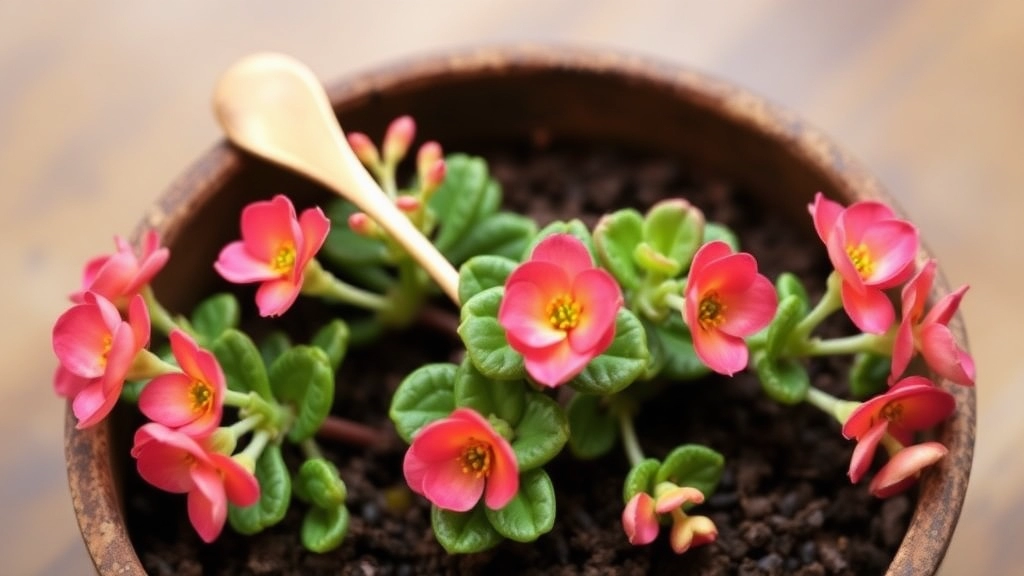Kalanchoe Copper Spoons: A Unique Touch for Your Space
Looking to add a unique touch to your garden or indoor space? The Kalanchoe Copper Spoons, also known as Kalanchoe Orgyalis, is a stunning succulent that’s gaining popularity in Australia. With its distinctive copper-coloured leaves and minimal care requirements, it’s perfect for both novice and experienced gardeners.
Your Guide to Kalanchoe Copper Spoons
In this guide, I’ll cover everything you need to know about Kalanchoe Copper Spoons in Australia. From its unique features and growing conditions to where you can buy it and how to care for it year-round, you’ll find all the essential information to keep your plant thriving.
Overview of Kalanchoe Copper Spoons
Are you looking for a unique succulent to add to your collection?
Kalanchoe Copper Spoons, also known as Kalanchoe orgyalis, is a captivating choice that combines beauty and resilience.
This succulent features thick, spoon-shaped leaves with a striking copper hue, making it a standout plant for both gardens and indoor spaces.
Key Characteristics
- Leaf Shape: The leaves resemble spoons, giving it a distinctive appearance.
- Colour: Its coppery tones can change with light exposure, adding dynamic beauty to your plant display.
- Size: Typically grows to about 30-60 cm in height, making it suitable for various settings.
Kalanchoe Copper Spoons is not just visually appealing; it’s also relatively easy to care for, which is a significant plus for both novice and experienced gardeners.
Next Steps
In the following section, we’ll explore the unique features of the Copper Spoons succulent that set it apart from other plants. For more detailed guidance on caring for Kalanchoe Copper Spoons, check out our complete guide to growing Kalanchoe Copper Spoons. If you’re interested in other unique varieties, you might also find our Kalanchoe Beharensis care and propagation tips helpful.
Unique Features of Copper Spoons Succulent
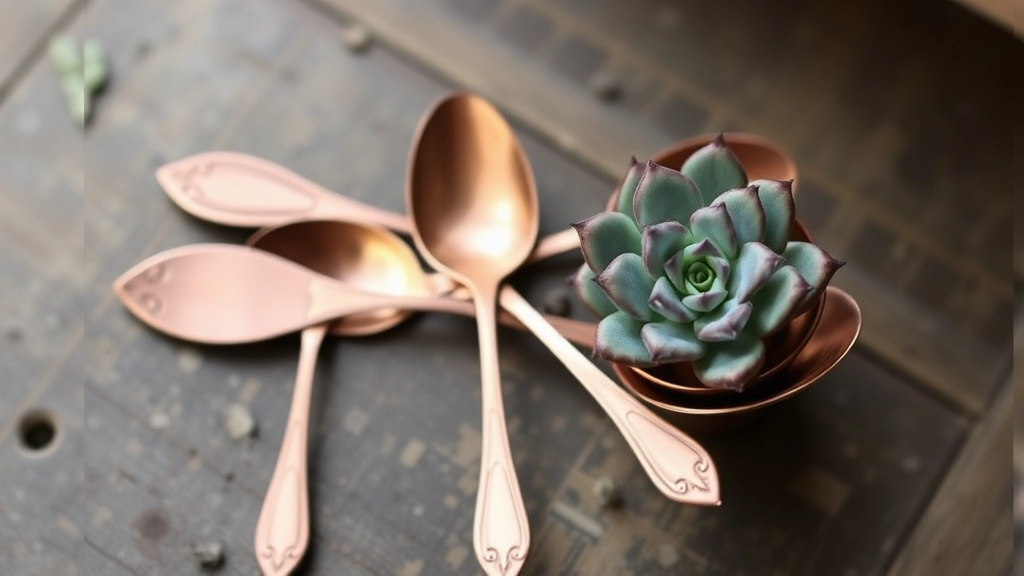
So, you’re curious about what makes the Kalanchoe Copper Spoons succulent stand out?
Let me tell you, this plant is like no other.
Distinctive Leaves
First off, the leaves are a real showstopper.
- Shape: They’re thick, oval, and spoon-shaped, which is where the name comes from.
- Colour: The leaves have a stunning coppery hue that can change with the seasons, giving your plant a unique look all year round.
Resilience
One of the best features?
This succulent is incredibly resilient.
- Drought Tolerance: It can handle dry spells like a champ.
- Low Maintenance: Perfect for those of us who might forget to water now and then.
Growth Habit
The growth habit is pretty cool too.
- Compact Size: It stays relatively small, making it ideal for both indoor pots and small garden spaces.
- Upright Growth: The plant tends to grow upright, which adds a nice vertical element to your arrangement.
Flowers
And let’s not forget about its flowers.
- Blooms: When it flowers, it produces clusters of small, tubular blooms that can be a lovely addition to any garden.
Growing Conditions in Australian Climates
When considering the ideal conditions for Kalanchoe Copper Spoons, many Australians wonder how well this succulent will adapt to local climates.
Understanding Australian Climates
Australia is known for its diverse climate zones, from tropical in the north to temperate in the south. Kalanchoe Copper Spoons thrives best in the following conditions:
- Temperature: Prefers temperatures between 15°C and 30°C.
- Humidity: Enjoys low to moderate humidity levels, making it suitable for most Australian regions.
- Rainfall: While it can tolerate brief periods of rain, prolonged wet conditions can lead to root rot.
Choosing the Right Location
Selecting the right spot in your garden or home is crucial:
- Outdoor: If planting outdoors, choose a location that receives full sun to partial shade. Morning sunlight is ideal.
- Indoor: For indoor cultivation, place it near a south-facing window for optimal light exposure.
Seasonal Considerations
Australian seasons can affect your Kalanchoe’s growth:
Soil and Potting Mix Requirements for Kalanchoe Copper Spoons
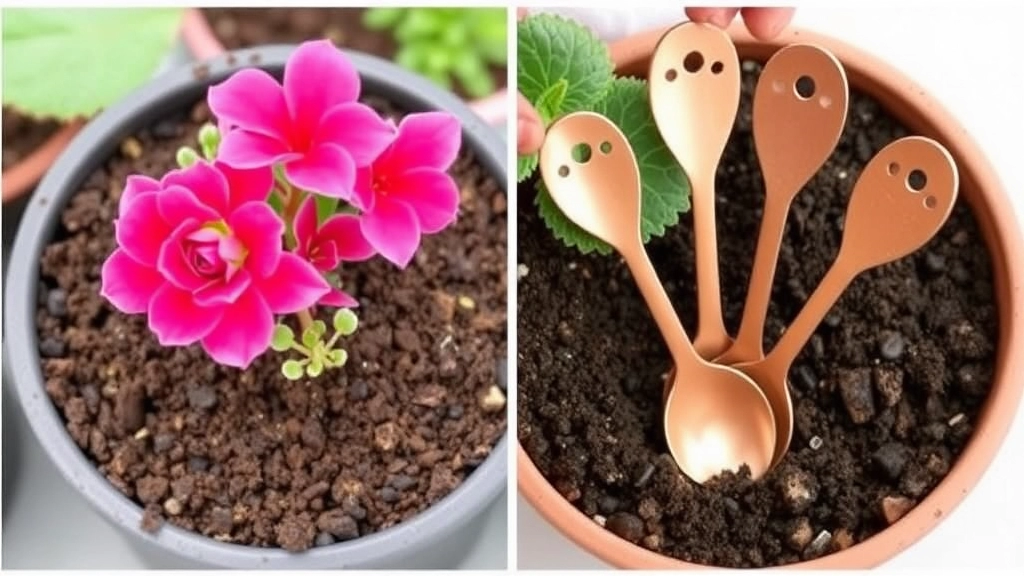
When it comes to nurturing your Kalanchoe Copper Spoons, the right soil and potting mix are essential for optimal growth.
What Should You Use?
Kalanchoe Copper Spoons thrive in well-draining soil. This is crucial because succulents are prone to root rot if left in soggy conditions.
Here’s what to consider:
- Cactus or Succulent Mix: Use a commercial cactus or succulent potting mix. These blends typically contain sand, perlite, or pumice, promoting excellent drainage.
- DIY Mix: If you prefer a homemade option, combine:
- 2 parts potting soil
- 1 part coarse sand
- 1 part perlite or pumice
- pH Level: Aim for a slightly acidic to neutral pH (around 6.0 to 7.0). This range supports healthy root development.
Potting Tips:
- Container Choice: Ensure your pot has drainage holes. Terracotta pots are excellent as they allow for air circulation and moisture control.
- Repotting: Consider repotting every couple of years to refresh the soil and provide room for growth.
Using the right soil and potting mix will set your Kalanchoe Copper Spoons up for success, allowing them to flourish in your home or garden.
Light and Watering Needs
When it comes to caring for Kalanchoe Copper Spoons, understanding its light and watering needs is crucial for a thriving plant. Many enthusiasts often wonder how much sunlight their succulents need and how often they should water them.
Light Requirements
Kalanchoe Copper Spoons thrive in bright, indirect sunlight. Here’s what you should keep in mind:
- Direct Sunlight: While they can tolerate some direct sun, too much can scorch their leaves. Aim for about 4-6 hours of filtered sunlight daily.
- Indoor Placement: If you’re growing them indoors, a south or west-facing window is ideal. Just ensure they’re not in the harsh afternoon sun.
- Signs of Insufficient Light: If the leaves start to stretch or lose their vibrant colour, it’s a sign they need more light.
Watering Needs
Watering is another critical aspect of Kalanchoe Copper Spoons care. Overwatering can lead to root rot, while underwatering can cause the plant to wilt. Here are some straightforward tips:
Common Pests and How to Protect the Plant

So, you’ve got your Kalanchoe Copper Spoons thriving, but what happens when those pesky pests decide to crash the party?
Common Pests to Watch For:
- Mealybugs: These little white fluff balls love to hide in the crevices of your plant.
- Aphids: Tiny green or black bugs that suck the sap right out of your succulent.
- Spider Mites: If you notice fine webbing on your plant, these guys are likely the culprits.
- Scale Insects: They look like small bumps on the leaves and can be tricky to spot.
Protecting Your Copper Spoons:
- Regular Inspection: Check your plants weekly. Catching pests early makes a world of difference!
- Neem Oil: A natural pesticide that’s effective against many pests. Just mix it with water and spray.
- Insecticidal Soap: This can help wash away bugs without harming your plant.
- Isolation: If you spot an infested plant, move it away from your other plants to prevent spreading.
- Healthy Environment: Ensure your plant is healthy and stress-free; a strong plant is less likely to attract pests.
Best Uses in Gardens and Indoor Spaces
When considering where to place Kalanchoe Copper Spoons, it’s essential to think about how its unique aesthetic can enhance various environments.
Outdoor Gardens
Kalanchoe Copper Spoons (Kalanchoe orgyalis) are a striking addition to any garden. Their distinctive, spoon-shaped leaves and coppery hue create a visual focal point. Here are some ideal uses in outdoor settings:
- Rock Gardens: Their succulent nature makes them perfect for rock gardens, where they can thrive in well-draining soil.
- Border Planting: Planting them along pathways or borders adds texture and colour.
- Container Gardens: They do exceptionally well in pots, allowing for mobility and versatility in design.
Indoor Spaces
Kalanchoe Copper Spoons also shine indoors, offering a touch of nature to your living spaces. Consider these placements:
- Windowsills: They love sunlight, making a bright windowsill an ideal spot.
- Office Desks: Their low-maintenance nature makes them perfect for busy professionals looking to liven up their workspace.
- Living Rooms: Use them as statement pieces on coffee tables or shelves.
Versatile Decor
The versatility of Kalanchoe Copper Spoons means they can adapt to various decor styles:
- Modern: Their sleek, minimalistic look complements contemporary designs.
- Rustic: Pair them with natural materials for a more organic feel.
- Tropical: Combine them with other succulents for a lush, vibrant display.
For more detailed care instructions, you can refer to our complete care guide for Kalanchoe Panda Plant. Additionally, if you are interested in other Kalanchoe varieties, check out our comprehensive Kalanchoe species list for gardeners.
Companion Plants for Kalanchoe Copper Spoons
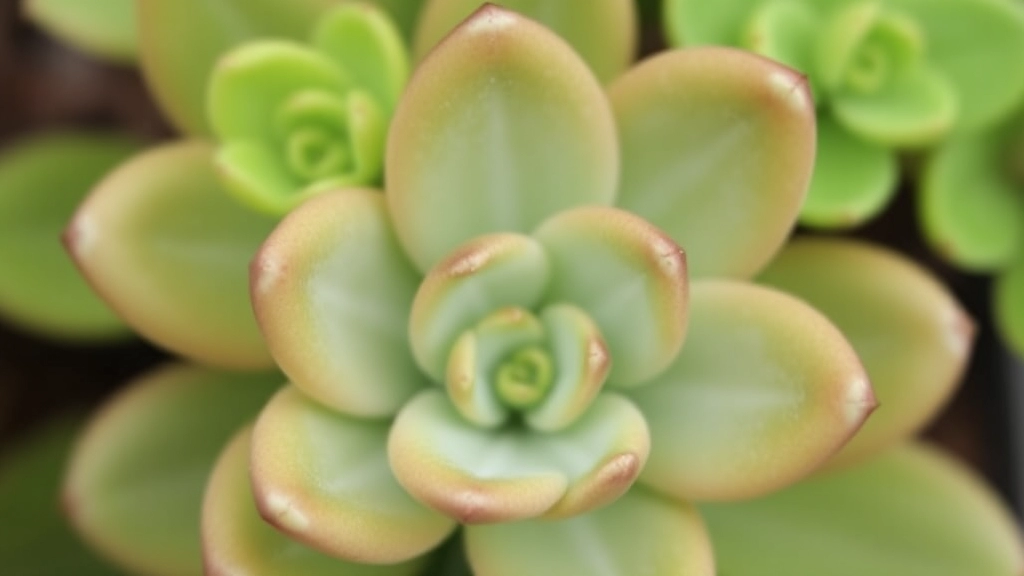
So, you’ve got your Kalanchoe Copper Spoons thriving, and now you’re wondering what plants would make great companions. Pairing your succulents with the right plants can enhance your garden or indoor space, creating a vibrant and harmonious atmosphere.
Why Companion Plants Matter
Companion planting isn’t just about aesthetics; it can also promote healthier growth. Here’s what to consider:
- Similar Watering Needs: Choose plants that require similar watering schedules to prevent over or under-watering.
- Pest Control: Certain plants can deter pests that might otherwise munch on your Kalanchoe.
- Aesthetic Appeal: Mixing textures and colours can make your space pop.
Top Companion Plants for Kalanchoe Copper Spoons
Here are some fantastic companions for your Copper Spoons:
- Aloe Vera: This hardy succulent thrives in similar conditions and adds a lovely green contrast.
- Sedum: With its diverse varieties, Sedum can provide a splash of colour and texture while sharing similar care requirements.
- Echeveria: These rosette-shaped succulents not only look stunning but also enjoy the same light and soil conditions.
- Hens and Chicks (Sempervivum): These charming plants are perfect for rock gardens and can tolerate drought, making them ideal partners.
- Agave: If you have space, Agave plants can create a striking focal point alongside your Copper Spoons.
Tips for Planting Together
- Spacing: Ensure there’s enough space between plants to allow for airflow, which helps prevent mould and rot.
- Soil Type: Use a well-draining potting mix that suits all your chosen plants.
- Sunlight: Position your companions where they can all bask in the sun without overshadowing each other.
Pairing your Kalanchoe Copper Spoons with these companions not only enhances their beauty but also creates a thriving ecosystem in your garden or home.
Where to Buy Kalanchoe Copper Spoons in Australia
Finding Kalanchoe Copper Spoons can be a bit of a quest, especially if you’re keen on adding this unique succulent to your collection.
Many gardeners often wonder where they can source these stunning plants.
Local Nurseries and Garden Centres
- Visit Local Nurseries: Many independent nurseries stock Kalanchoe varieties, including Copper Spoons.
- Check Garden Centres: Larger garden centres often have a diverse range of succulents.
Online Retailers
- E-commerce Platforms: Websites like eBay and Etsy frequently feature sellers offering Kalanchoe Copper Spoons.
- Specialty Plant Stores: Online stores focused on succulents may have them available for delivery.
Plant Expos and Markets
- Attend Local Plant Fairs: These events are a fantastic opportunity to find rare plants and connect with other enthusiasts.
- Farmers’ Markets: Sometimes, local vendors sell unique succulents at these markets.
Social Media and Plant Groups
- Join Facebook Groups: Many gardening communities share tips on where to find specific plants.
- Instagram: Search for hashtags like #KalanchoeCopperSpoons to discover local sellers.
By exploring these avenues, you can easily find Kalanchoe Copper Spoons to enhance your garden or indoor space. For more detailed care tips, you might want to check out our expert tips for thriving Kalanchoe plants and our complete guide to growing Kalanchoe Pink Butterflies.
Tips for Propagating Kalanchoe Orgyalis
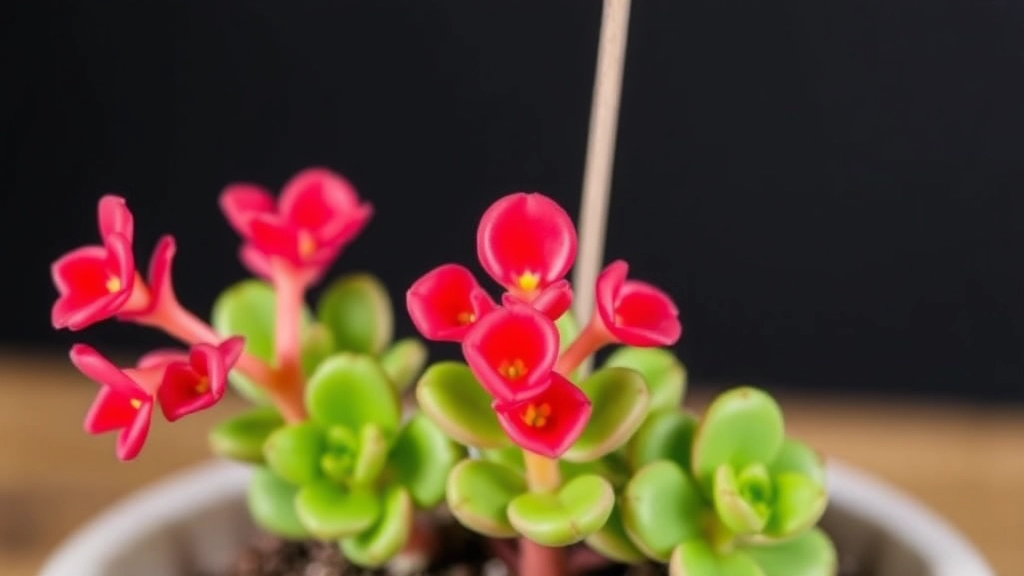
So, you’re keen to propagate your Kalanchoe Copper Spoons, huh? That’s awesome! Propagation is a fantastic way to expand your collection or share with friends. Let’s dive into some straightforward tips that’ll make the process smooth and successful.
1. Choose the Right Time
- Spring or Summer: These seasons are ideal for propagation. The warmer temperatures encourage growth.
2. Select Healthy Leaves
- Pick the Best: Choose plump, healthy leaves from your Kalanchoe Orgyalis.
- Avoid Damage: Make sure the leaves are free from pests or disease.
3. Let Them Callus
- Drying Out: After removing the leaves, let them sit in a dry place for a few days. This helps form a callus over the cut surface, preventing rot.
4. Use the Right Soil
- Well-Draining Mix: A cactus or succulent mix works wonders. You can also mix regular potting soil with sand for better drainage.
5. Water Sparingly
- Initial Watering: After placing the leaves in the soil, wait about a week before watering. This helps avoid rot.
- Keep It Light: When you do water, just mist lightly. Too much moisture can be a killer.
6. Provide Indirect Light
- Bright, Indirect Sunlight: Place your cuttings in a spot where they get plenty of light but not direct sun. This helps them root without burning.
7. Be Patient
- Rooting Time: It can take a few weeks for roots to develop. Don’t rush it! Keep an eye on them, but give them space to grow.
8. Transplanting
- Move When Ready: Once you see roots forming, you can transplant them into their own pots. Make sure to use the same well-draining soil.
Seasonal Care and Maintenance
As we delve into the seasonal care and maintenance of Kalanchoe Copper Spoons, it’s essential to understand how these unique succulents thrive throughout the year.
Spring: Awakening Growth
Spring is a time of renewal for your Copper Spoons.
- Watering: Increase watering as temperatures rise, ensuring the soil dries out between waterings.
- Fertilisation: Apply a balanced succulent fertiliser every four to six weeks to promote healthy growth.
- Repotting: Consider repotting if the plant has outgrown its container, using a well-draining mix.
Summer: Thriving in Warmth
During the summer months, your Copper Spoons will be at their most vibrant.
- Watering: Maintain a consistent watering schedule, but avoid overwatering. Check the soil moisture regularly.
- Sun Protection: While they enjoy bright light, provide some shade during the hottest part of the day to prevent sunburn.
Autumn: Preparing for Dormancy
As temperatures cool, your Copper Spoons will begin to prepare for dormancy.
- Watering: Gradually reduce watering frequency as growth slows down.
- Fertilisation: Stop fertilising to allow the plant to rest.
Winter: Dormant Care
In winter, your Copper Spoons will enter a period of dormancy.
- Watering: Water sparingly, ensuring the soil remains dry for longer periods.
- Temperature: Keep them in a warm area, away from frost. Ideally, temperatures should remain above 10°C.
General Maintenance Tips
- Pruning: Remove any dead or damaged leaves throughout the year to encourage new growth. For more detailed pruning techniques, check out our guide on pruning Kalanchoe plants.
- Pest Check: Regularly inspect for pests, particularly after seasonal changes. If you notice any issues, our troubleshooting guide can help you address common problems.
By following these seasonal care tips, your Kalanchoe Copper Spoons will remain healthy and vibrant.
So, you’ve got your Kalanchoe Copper Spoons all set up, and now you’re curious about the other fabulous Kalanchoe varieties that can thrive in Australia.
### Kalanchoe Blossfeldiana
This one’s a classic! Known for its vibrant flowers, Kalanchoe Blossfeldiana comes in a range of colours.
– **Flowering Season:** Late winter to early spring
– **Care Level:** Easy to moderate
For more detailed care tips, check out our [complete care guide for Kalanchoe Blossfeldiana succulent](https://planthq.org/complete-care-guide-for-kalanchoe-blossfeldiana-succulent/).
### Kalanchoe Tomentosa (Panda Plant)
With its fuzzy leaves, this variety is often called the Panda Plant. It’s super cute and a bit quirky.
– **Unique Feature:** Leaves are covered in fine hairs that give them a silvery appearance.
– **Care Level:** Easy
Learn how to provide the best care with our [complete guide to Kalanchoe Tomentosa](https://planthq.org/how-to-care-for-kalanchoe-tomentosa-complete-guide-2/).
### Kalanchoe Luciae (Flapjack Plant)
If you want a plant that’s as striking as it is easy to care for, look no further than the Flapjack Plant.
– **Leaf Shape:** Flat, paddle-like leaves that turn a lovely red in full sun.
– **Care Level:** Easy
### Kalanchoe Orgyalis (Copper Spoons)
Of course, we can’t forget our star! The Copper Spoons are known for their unique, spoon-shaped leaves.
– **Unique Feature:** Leaves have a coppery hue that’s stunning.
– **Care Level:** Easy
### Kalanchoe Fedtschenkoi (Lavender Scallops)
This one’s a bit of a show-off with its scalloped leaves and lovely lilac hue.
– **Growth Habit:** Grows upright and can reach up to 60 cm tall.
– **Care Level:** Moderate
### Kalanchoe Marmorata (Pencil Plant)
With its marbled leaves, this succulent is a real eye-catcher.
– **Unique Feature:** The leaves have a striking pattern that resembles marble.
– **Care Level:** Moderate
### Kalanchoe Humilis (Kalanchoe of the Lowlands)
This variety is perfect for rock gardens. It’s low-growing and spreads out nicely.
– **Growth Habit:** Ground cover with thick, fleshy leaves.
– **Care Level:** Easy
### Why Choose These Varieties?
Each of these Kalanchoe varieties brings something unique to the table, whether it’s vibrant flowers, interesting leaf shapes, or stunning colours.
When you mix and match these plants, you can create a visually appealing garden or indoor space that’s sure to impress.
FAQs about Kalanchoe Copper Spoons in Australia
What makes the Kalanchoe Copper Spoons succulent unique?
The Kalanchoe Copper Spoons is known for its distinctive, thick, oval, spoon-shaped leaves with a stunning coppery hue that changes with the seasons. This succulent is also incredibly resilient, drought-tolerant, and low-maintenance.
What kind of soil and potting mix should I use for Kalanchoe Copper Spoons?
Kalanchoe Copper Spoons thrive in well-draining soil. A commercial cactus or succulent potting mix is ideal, but you can also make a DIY mix using 2 parts potting soil, 1 part coarse sand, and 1 part perlite or pumice. Aim for a slightly acidic to neutral pH (around 6.0 to 7.0).
How should I care for my Kalanchoe Copper Spoons to prevent pests?
Regularly inspect your plants for pests like mealybugs, aphids, spider mites, and scale insects. Use neem oil or insecticidal soap as needed, and isolate infested plants to prevent spreading. Maintaining a healthy environment for your plant also helps deter pests.
What are some good companion plants for Kalanchoe Copper Spoons?
Companion plants that have similar watering needs and can enhance the aesthetic appeal of your garden include Aloe Vera, Sedum, Echeveria, Hens and Chicks (Sempervivum), and Agave. Ensure proper spacing and use well-draining soil for all plants.
How do I propagate Kalanchoe Copper Spoons?
To propagate, choose healthy leaves during spring or summer. Let the leaves callus for a few days before placing them in well-draining soil. Water sparingly and provide bright, indirect sunlight. Be patient, as it can take a few weeks for roots to develop.
What type of container is best for Kalanchoe Copper Spoons?
Choose a pot with drainage holes to prevent waterlogging. Terracotta pots are excellent as they allow for air circulation and moisture control. Repotting every couple of years can refresh the soil and provide room for growth.
How often should I water my Kalanchoe Copper Spoons?
Water your Kalanchoe Copper Spoons sparingly. It’s better to let the soil dry out between waterings to prevent root rot. This succulent is drought-tolerant and can handle occasional neglect.
What kind of light does Kalanchoe Copper Spoons need?
Kalanchoe Copper Spoons thrive in bright, indirect sunlight. Too much direct sunlight can cause the leaves to burn, while too little light can hinder growth.
What should I do if my Kalanchoe Copper Spoons gets pests?
If you notice pests, isolate the affected plant immediately. Use neem oil or insecticidal soap to treat the pests. Regular inspections can help catch issues early, making treatment easier and more effective.
Can Kalanchoe Copper Spoons be grown indoors?
Yes, Kalanchoe Copper Spoons can be grown indoors as long as they receive bright, indirect sunlight and are planted in well-draining soil. Their compact size makes them ideal for indoor pots.
References
-
Growing Kalanchoe Copper Spoons: Tips and Tricks
-
Kalanchoe Copper Spoons Care Guide
-
Kalanchoe Copper Spoons: Care and Propagation
